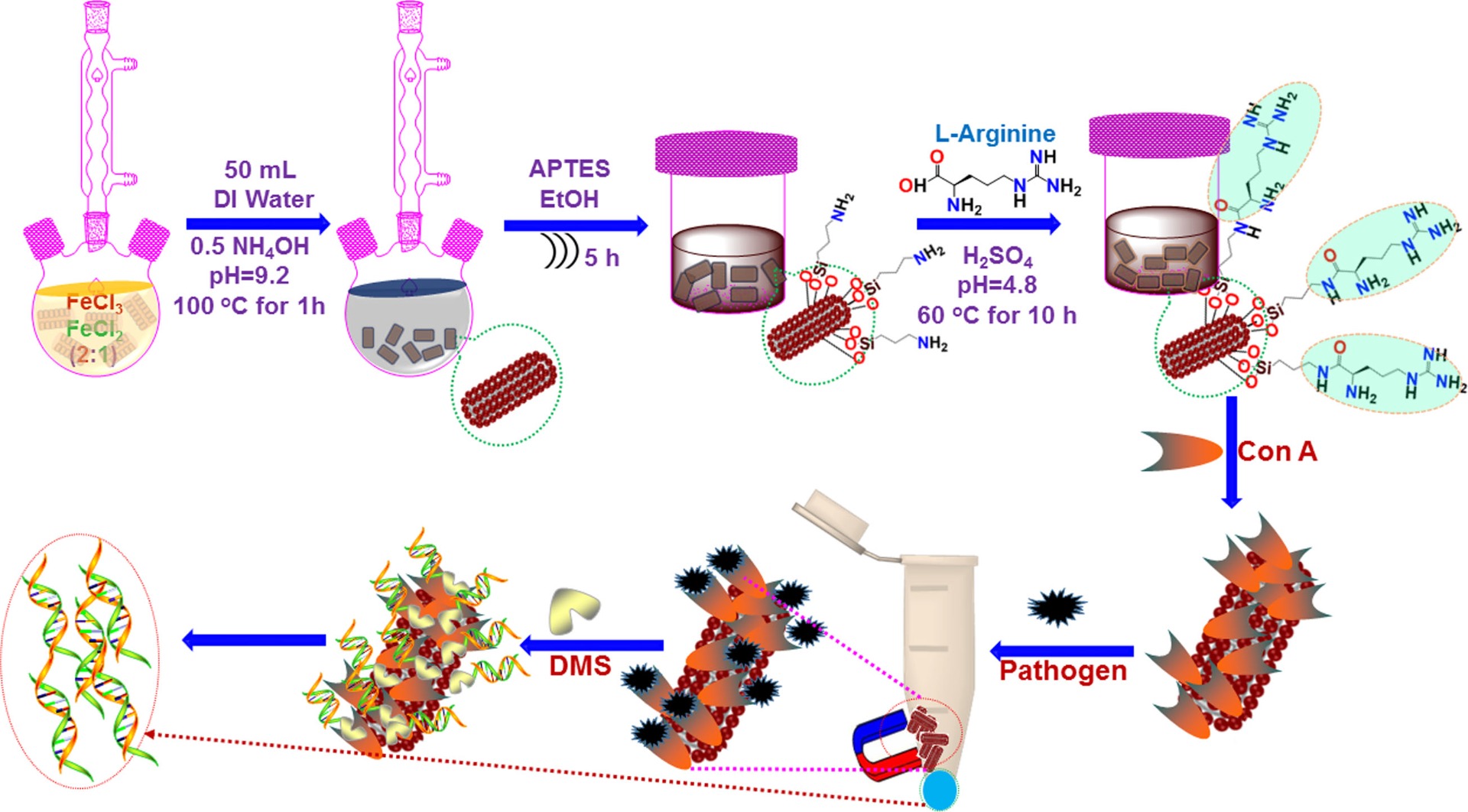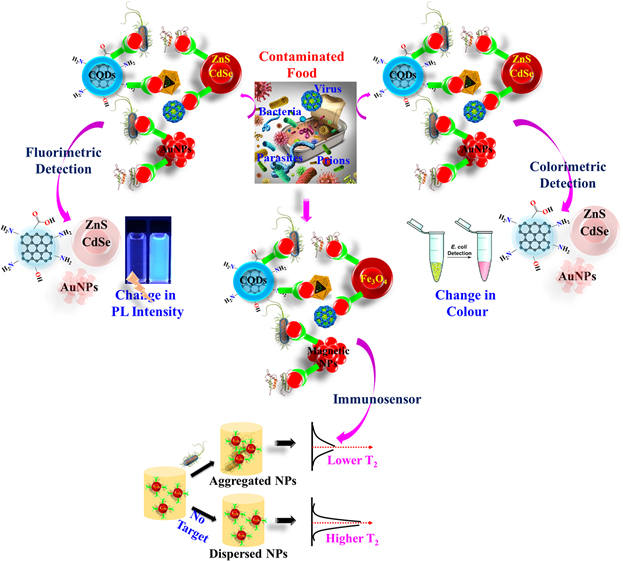Research Areas
- Synthesis and characterization of nanomaterials, Inorganic complexes, and metal-organic frameworks (MOFs) for organic catalytic reactions.
- An advanced, novel, and eco-friendly core/shell liposomal nanoparticles preparation for the therapeutic targeted drug delivery application in vitro and in vivo as well.
- Nanomaterial mediated electrochemical sensor application to detect and analyze different biomolecules that are responsible for the causing of several important diseases to human beings.
An innovative fluorescent probe-based sensing and bio-sensing approach.
Ternary hybrid catalysts for the H2 production via photoelectrochemical water splitting.
Nanoparticle mediated micromotor applications for industrial applications.
Hybrid binary and ternary nanomaterials for the water purification technology.
Isolation and chemical modifications of bioactive compounds and secondary metabolites from bacteria for medical applications.
Plausible working mechanism for the detection of hydrocortisone using Naf-CoO nanoparticles via electrochemical approach.

Schematic representation for the synthesis of Ru-Cur complex and RCLNPs towards the screening of anticancer applications.

Plausible schematic diagram of the working mechanism for the ROS-induced effects mediated by the RCLNPs against HeLa cells.

List
of highly toxic and OP pesticides with different organic skeleton moieties.

Single
crystal structures of organophosphate hydrolyze enzymes. Protein data bank has
been used for the representation of structures. Top left to right: crystal
structure of organophosphate acid hydrolase OPAA (PDB: 3L7G), the crystal
structure of serum paraoxonase PON1 (PDB: 1V04), and crystal structure of
phosphotriesterase-like lactonase SsoPox (PDB: 2VC5), bottom left to right:
crystal structure of diisopropylfluorophosphatase DFPase (PDB: 1E1A), the
crystal structure of zinc-containing phosphotriesterase PTE (PDB: 1HZY), and
crystal structure of phosphotriesterase OpdA (PDB: 2D2J).

Degradation of fenamiphos OP pesticide in the
presence of fenamiphos hydrolyzing enzyme (FHE) which is a type of phosphotriesterase PTE was isolated from the Microbacterium
esteraromaticum.

Schematic representation
of the synthesis of L-arginine-functionalized mag-DE NPs for the detection of
toxic bacteria and their genetic material. Mag-DE NPs, magnetic diatomaceous
earth nanoparticles.

Two-dimensional plots of
the exosome fluorescence-activated cell sorting analysis. Exosomes were
isolated from human colon carcinoma HCT116 cell line: negative control (A);
exosome isolation kit (B); magnetic diatom (C). Purified exosomes were analyzed
by using fluorescence-activated cell sorting (FACS). SSC: side-scattered light;
FSC: forward-scattered light; FITC: fluorescein isothiocyanate.

Carbon quantum dots and its hybrid nanomaterials from Persimmon fruit for caspase induced apoptosis, anti-cancer, and biological imaging applications.
(a) Schematic of the invisible security ink made of NH2-MIL-125(Ti) and its (b) fluorescence quenching and recovery mechanisms.
Encryption using (a) a rubber stamp and (b) an ink pen and subsequent decryption of (I) pure NH2-MIL-125(Ti), (ii) with Pb2+ addition, and (iii) after EDTA addition, as observed in the UV-vis region (260-360 nm).

Schematic illustration for the
synthesis of gC3N4@CdS-Fe3O4 ternary nanohybrids via the hydrothermal method and PEC water splitting for the
hydrogen gas production.

Schematic illustration for the preparation of workstation to produce H2 gas via PEC water splitting

Schematic illustration for the complete synthesis of BSA-AuNCs via hydrothermal and detection of epinephrine by fluorescence enhancement approach.

Schematic representation of plausible working mechanism for fluorescence enhancement of gold nanoclusters (BSA-AuNCs) in the presence of epinephrine.

Acetyl curcumin loaded PLGA polymer Core/shell liposome nanoparticles for kinetically controlled drug delivery, bio-imaging, screening of anticancer applications.

Synthesis of Carbon Dots from EDTA vis hydrothermal method for the selective and sensitive detection of Ca2+ ions in human serum using fluorescence assay

Preparation of Carbon Dots from mushrooms as a carbon source and have been applied for the metal ions sensing, bactericidal and bioimaging applications.

Schematic illustration of different strategies in nanomaterial based biosensors for the foodborne pathogen detection.

Schematic representation of electrochemical biosensor system for the foodborne pathogen detection.

Synthesis of the activated diatomaceous earth (DE) and its motor behavior in the presence of low concentrations of H2O2, on the other hand, micromotor behavior inhibition by the addition of EDTA.

Time-lapse images taken at 3 s intervals and it demonstrate the typical motion of a diatom micromotor in 0.8% H2O2. (b) Schematic illustration of a plausible movement mechanism for the diatom micromotor propelled by hydrogen peroxide fuel.

Turn-on diatom fluorescence towards aliphatic amine binding

Schematic presentation for the preparation of BSA-AU NCs for the selective and sensitive detection of dopamine in cerebrospinal fluid (CSF) vis fluorescence method.

Synthesis of polystyrene anchored amino acid attached peroxotungstun complexes for the selective oxidation of organic sulfur compounds to corresponding sulfoxides and sulfones via a green approach.

Preparation of water soluble, hydrolytically stable and well-defined peroxo derivatives of tungsten supported on macromolecular matrices for the potent inhibitors of two different types of phosphohydrolases such as ALP and ACP via inhibition of enzyme activity.
